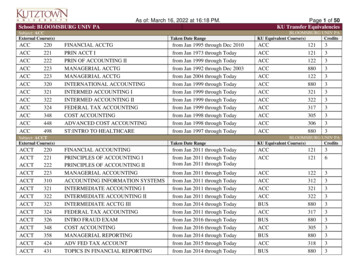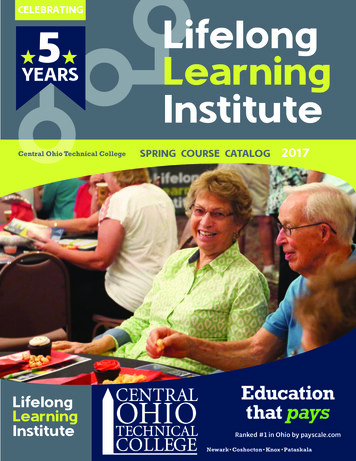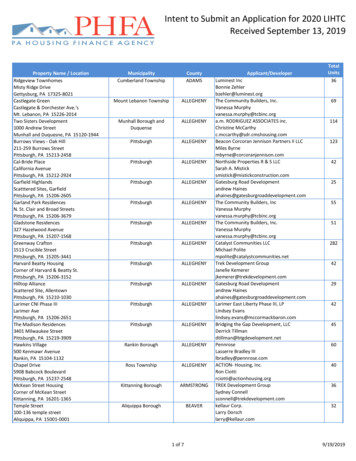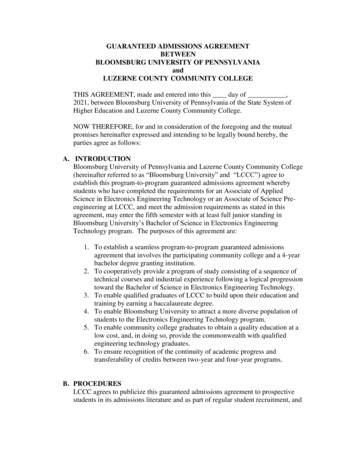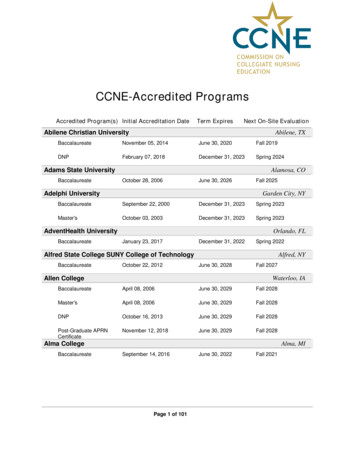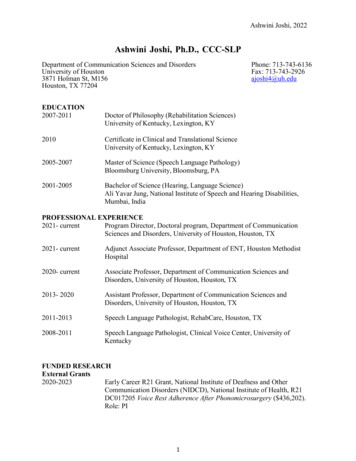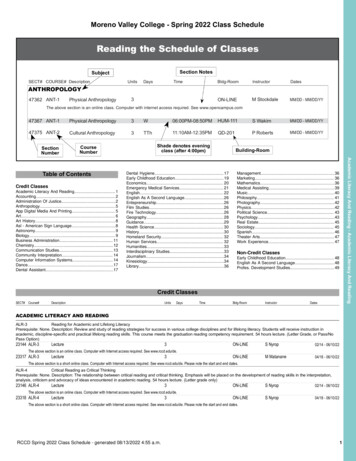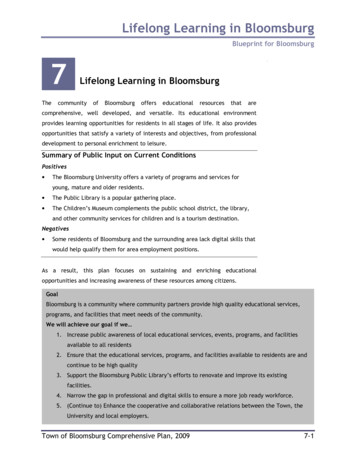
Transcription
Lifelong Learning in BloomsburgBlueprint for Bloomsburg 7TheLifelong Learning in sourcesthatarecomprehensive, well developed, and versatile. Its educational environmentprovides learning opportunities for residents in all stages of life. It also providesopportunities that satisfy a variety of interests and objectives, from professionaldevelopment to personal enrichment to leisure.Summary of Public Input on Current ConditionsPositives The Bloomsburg University offers a variety of programs and services foryoung, mature and older residents. The Public Library is a popular gathering place. The Children’s Museum complements the public school district, the library,and other community services for children and is a tourism destination.Negatives Some residents of Bloomsburg and the surrounding area lack digital skills thatwould help qualify them for area employment positions.As a result, this plan focuses on sustaining and enriching educationalopportunities and increasing awareness of these resources among citizens.GoalBloomsburg is a community where community partners provide high quality educational services,programs, and facilities that meet needs of the community.We will achieve our goal if we 1. Increase public awareness of local educational services, events, programs, and facilitiesavailable to all residents2. Ensure that the educational services, programs, and facilities available to residents are andcontinue to be high quality3. Support the Bloomsburg Public Library’s efforts to renovate and improve its existingfacilities.4. Narrow the gap in professional and digital skills to ensure a more job ready workforce.5. (Continue to) Enhance the cooperative and collaborative relations between the Town, theUniversity and local employers.Town of Bloomsburg Comprehensive Plan, 20097-1
Chapter 7Blueprint for Bloomsburg A Lifelong Range of Educational OpportunitiesThe community of Bloomsburg offers a range of educational services, programs,and facilities for residents in all stages of life and age groups.For children and youth, the community offers nizations and institutions. Public schooling isavailable through the Bloomsburg Area School onal-Technical School (Grades 9 – 12). Thereare opportunities for private schooling at theColumbia Child Development Center (Preschool) andSt. Columba Catholic School (Preschool – Grade 8). The local Boy Scout and GirlScout Troops, the YMCA, the Children’s Museum, and Bloomsburg University’sReading Center offer enrichment programs for the community’s youngestresidents.For the college bound and professionals, Bloomsburg University is the focus.Services include career counseling and planning for university students andAlumni through the Career Development Center; tutoring, academic advising, andother support services for university students through the Department ,corporateandcustomized job training for professionals of all ages through the Division ofCorporate and Continuing Education. Bloomsburg University also offers programs,such as the Upward Bound Program and the Advance College Experience Program,which prepare local high school students for post-secondary education.Learning opportunities are also available for retirees and seniors primarilythrough local senior centers and the YMCA. These programs encourage people toremain mentally active in their later years. They also promote social interactionand community involvement and can provide opportunities for sharing knowledgeas well.Town residents have access to excellent educational and enrichment resources.Among these are the Bloomsburg Public Library and Bloomsburg University’s7-2Town of Bloomsburg Comprehensive Plan, 2009
Lifelong Learning in BloomsburgBlueprint for BloomsburgHarvey A. Andruss Library. Both are open to university students and the general public. Bloomsburg University also offers a lecture series, non-degree for creditcourses, cultural events and recreational programs to the public. And theBloomsburg Theatre Ensemble offers a variety of educational opportunities.Since the Town of Bloomsburg’s current educational services, programs, andfacilities adequately support lifelong learning in the community, the LifelongLearning plan aims to ensure that these resources continue to offer a variety oflearning opportunities for residents. It also aims to increase public awareness ofthese resources to ensure that they are well used by the community.RecommendationsLL.1.Establish a Lifelong Learning Committee responsible for promotinglearning opportunities as a way of life for Bloomsburg residents. Thecommittee, comprised of educational and civic leaders, would beresponsible for gathering information about educational resources andmaking it available to the public online (see below).LL.2.Develop and maintain a Lifelong Learning webpage on the Town’swebsite. The webpage would provide links to educational institutions andorganizations in the Bloomsburg area. It would also link to the ColumbiaMontour Visitors Bureau community calendar where special events andseasonal programs could be posted.LL.3.Develop and distribute an annual update on educational services,programs, and facilities available to residents in the area. The contentwould focus on programs offered to all members of the community andcould direct readers to the Lifelong Learning webpage for moreinformation and links. The update could be incorporated into existingnewsletters distributed by educational entities or the Town.LL.4.Encourage Bloomsburg University to evaluate its advertising ofeducational services and programs available to the public as nonstudents. Indeed the University’s primary focus is on undergraduate andgraduate academic programs. However, it offers a variety of educationaland cultural enrichment programs as well as public access to its libraryand other select facilities. Residents’ use of these free or low cost highereducational resources to date may be limited by a lack of awareness,Town of Bloomsburg Comprehensive Plan, 20097-3
Chapter 7Blueprint for Bloomsburg which, in turn, may foster negative perceptions of the University as acommunity member. Evaluating and refining advertising methods mayprovide an opportunity for the University to strengthen participation in itscommunity programs and its image among residents.Lead Partners: Town CouncilSupport Partners: Bloomsburg Area School District, Columbia-Montour AreaVocational-Technical School, private schools, Children’s Museum, BloomsburgUniversity’s Division of Corporate and Continuing Education, Area Agency on Aging(senior centers), YMCA, Bloomsburg Public LibraryFunding Sources: Not applicable – volunteer and staff timePublic LibraryBloomsburg’s Public Library is located in the heart ofthe downtown business district and within a fewblocks of residential neighborhoods. The library es and the campus shuttle. On street andmetered parking as well as bike racks are available.Its central location makes it a convenient destinationfor many Town residents as well as an economic assetbecause of its ability to draw local residents anduniversity students to nearby businesses.The Library is a critical educational asset to the Town. The library provides freeaccess to quality reading materials and services that enable citizens to researchand reference these materials successfully. In addition, the library offers severaleducational programs that support literacy and reading among all ages. Theseprograms include weekly story time for preschoolers, youth reading clubs, adultbook clubs, and an award program that recognizes the reading achievements oflibrary members. The library also offers other educational opportunities forprofessional development, personal enrichment, or leisure. These opportunitiesrange from arts and crafts activities, such as scrapbooking classes, to guestlectures and special events.7-4Town of Bloomsburg Comprehensive Plan, 2009
Lifelong Learning in BloomsburgBlueprint for BloomsburgThe library partners formally and informally with other community organizations to promote reading and literacy in the community. It coordinates with the schooldistrict on reading challenges for elementary students. “Readers in Bloom” pairsUniversity students with community youth to improve reading skills. The libraryalso provides space for adult literacy programs provided by the CentralSusquehanna Intermediate Unit.Renovations to the library in 1998 doubled its size and requests for use of libraryspace and resources continued to grow. The library is increasingly used as ameeting place by community organizations. The library is currently undertakingsignificant renovations to provide more comfortable and inviting spaces in whichto hold formal and informal meetings, special events and other social gatherings.The library is also expanding its online resources. Continued investment in thelibrary’s endowment fund and support for these improvements is essential tostrengthening the library’s value to the community.The library is also home to Columbia County’s Historical and GenealogicalSociety. The society’s main office, archives and museum are located on thesecond floor and are open to the general public. The archives and museum areinstrumental in preserving and interpreting the Town’s history and culture.RecommendationsLL.5.Support local fundraising through in-kind services, such as use ofpublic facilities.LL.6.Coordinate marketing opportunities, i.e. to report progress onfundraising and renovations.LL.7.Sponsor or contribute to a special event that celebrates thecompletion of the renovations.LL.8.Promote the availability of the renovated library, as well as otheravailable facilities, for group meetings.LL.9.Invite the library to participate in the Lifelong Learning Committee.Lead Partners: Town of Bloomsburg/Town CouncilSupport Partners: Not applicableFunding Sources: Town BudgetTown of Bloomsburg Comprehensive Plan, 20097-5
Chapter 7Blueprint for Bloomsburg LL.10. Continue to partner with the Bloomsburg Area School District,Children’s Museum, YMCA and other community organizations onshared marketing.LL.11. Continue to explore local needs for programs, services and physicalspace and innovative library functions to sustain membership andcommunity support. Consider doing so formally through a strategicplan for the library.Lead Partners: Bloomsburg Public LibrarySupport Partners: Bloomsburg Area School District, Children’s Museum, YMCA andother community organizationsFunding Sources: PA Department of Education, Private foundationsThe Children’s MuseumThe museum is a non-profit corporation managed and operated by staff,volunteers, and a Board of Directors. The museum is located on West 7th Street,just off South Market Street, and is easily accessed by pedestrians, bicyclists, andautomobiles. The facility has on-street and off-street parking available. Itscentral location makes it a convenient tourism destination for visitors and localdestination for many Town residents.The Children’s Museum offers unique learning experiences tochildren of all ages by providing interactive learningmaterials. The museum offers hands-on exhibits at themuseum as well as traveling exhibits that serve 17 schooldistricts in the five county Central Susquehanna IntermediateUnit area. The museum’s exhibits are very diverse; topicsrange from science, to health, to culture, and are rotated forvariety. The museum also offers nine useful teaching kits forthe area’s classroom. Kits come complete with a teacher’sguide and enough materials for a full classroom of students. All kits are free ofcost and are conveniently available via mail. Teaching kits can be used inconjunction with classroom curriculum or for enrichment.7-6Town of Bloomsburg Comprehensive Plan, 2009
Lifelong Learning in BloomsburgBlueprint for Bloomsburg The museum converted a former firehouse into a large exhibition space, giftshop, and work room that is used for after school programs, arts and craftsprograms, or can be rented for special events. The museum hosts group andschool visits. It offers a variety of programs including children’s camps, arts andscience clubs, and weekly themed events and activities.The Children’s Museum is an important educational and economic asset to theTown for many reasons. Its interactive programs and services enrich thecommunity’s existing educational system while providing fun and interestingopportunities for local employment and civic volunteerism. The museum’sprograms and services also provide opportunities to interpret the Town’sdevelopmental natural and cultural history for local residents, students, andvisitors by incorporating related themes into its traveling and stationary exhibits.The museum is also used as a venue for parties, special events, programs, andgroup meetings, which gives it the ability to draw visitors and residentsdowntown and to nearby businesses.The museum plans to develop additional parking, a picnic area, and a newgarden. There are no current plans to expand or improve the museum’s indoorfacilities; however upgrades to the existing electrical system are needed.The museum partners with several local school districts in the area to fosterinteractive, hands-on learning opportunities for children in the community. Themuseum has also partnered with the Public Library, YMCA, and Chamber ofCommerce to promote its facility, programs and services. Such partnerships areessential to the cost-effective operation of the museum.The museum could create additional partnerships in the community in order topromote its programs and services. One way would be to directly link exhibitswith the community, businesses and organizations. Linking the exhibits to localprofessions will help children connect their museum experience to their emergingand developing skills and future employment dreams. To do this, the museumcould supplement its exhibits with a “state of the art” statement. This statementwould present current research topics and future research opportunities, pointingTown of Bloomsburg Comprehensive Plan, 20097-7
Chapter 7Blueprint for Bloomsburg young visitors to opportunities for cutting edge research and employment invarious fields. The museum could also supplement exhibits with a list of relatedlocal businesses or organizations as a way of connecting the exhibit with theBloomsburg community. For example, an exhibit on dentistry might include a listof local dentists, or a wildlife exhibit might list the nearest Pennsylvania GameCommission office. This type of information sharing could be coupled withfeature presentations given by a representative from one or more of thebusinesses or organizations listed.Funding for the museum comes from a variety of sources including program fees,admission fees, facility rentals, membership fees, and donations. Other funding isprovided to the museum by individual, corporate, and community donors.The museum is also supported by various grants. Many of the museum’s programsand services are supported by grants from the Pennsylvania Partners in the Arts(PPA), the regional arts funding partnership of the Pennsylvania Council of theArts (PCA), a state agency. State government funding comes through an annualappropriation by Pennsylvania’s General Assembly and from the NationalEndowment for the Arts. PPA is administered in the region by the Bradford CountyRegional Arts Council. The museum’s art camps are supported by the WoodcockFoundation for the Appreciation of the Arts. Its science camps and science clubare supported by a grant from Cherokee Pharmaceuticals.RecommendationsLL.12. Invite the Children’s Museum to participate in the Lifelong LearningCommittee.Lead Partners: Town of BloomsburgSupport Partners: Children’s MuseumFunding Sources: Not applicableLL.13. Promote availability of the museum as a venue for group meetings,especially related to children’s services.LL.14. Upgrade the existing electrical system.7-8Town of Bloomsburg Comprehensive Plan, 2009
Lifelong Learning in BloomsburgBlueprint for BloomsburgLL.15. Install new curbs and sidewalks to provide better access for pedestrians.LL.16. Advertise major changes in exhibits on the Columbia-Montour VisitorsBureau online community calendar.LL.17. Continue to partner with local school districts and other organizationsin the area to foster interactive, hands-on learning opportunities forchildren in the community.LL.18. Enhance exhibits by directly linking them with the community,businesses and organizations. Linking the exhibits to real life will helpchildren connect their experience to an attainable employment dream.LL.19. Seek dedicated long term funding, i.e. campaign to establish anendowment, for operating expenses.Lead Partners: Children’s MuseumSupport Partners: Public Library, YMCA, Chamber of Commerce,Bloomsburg UniversityFunding Sources: Existing sources, other private foundationsPreparing the Workforce for Local JobsBloomsburg’s local economy offers residents a variety of employment options inmany different fields. The Town’s local economy is primarily based on threebusiness or industry clusters as described in the Working and Doing Business inBloomsburg section of this plan. These three clusters include the Textile ProductsManufacturing Cluster, the University of Bloomsburg and Education Cluster, andthe Downtown Business District. These clusters, or major sectors, of the localeconomy are very different from one another in terms of the kinds of the jobsthey offer and the skill sets they require. Employment opportunities range fromtrade and labor jobs to sales and service to professional, administrative, andmanagerial jobs.The Columbia County 2006 Needs Assessment indicated that people in thecounty’s workforce are generally satisfied with their work, but think that findinggood work locally is a significant problem. The assessment’s conclusions werebased on a survey completed by 1,094 county residents.Town of Bloomsburg Comprehensive Plan, 20097-9
Chapter 7Blueprint for Bloomsburg Survey results show that among those respondents working, 92 percent ofthose working full time were somewhat satisfied or very satisfied with theiremployment. Despite this positive picture, 78 percent of respondents thinkthat finding good work is a problem. Among those employed full time, 41 percent think finding work is a problem.Among those employed part-time, 58 percent think finding good work is aproblem. Among those unemployed and looking for work, 68 percent think finding goodwork is a problem. Among those unemployed and not looking for work, 49 percent think findingwork is a problem. Among those with household incomes at or below the poverty line 69 percentbelieve that finding work is a large or very large problem.These sentiments reflect a significant disconnect between the needs and skills ofthe local workforce and the employment needs of the local employers in thecounty. While there are a variety of local job opportunities, there is a lack ofappropriately skilled workers to fill those positions. This is may be due to thefollowing factors: Gap in Digital Skills - the local workforce is not prepared for today’stechnology-based workplace Brain Drain – young people with technical and technological skills leave forhigher education or job opportunities elsewhere Lack of interest or willingness - the local workforce is uninterested inavailable job opportunities or are unwilling to work local jobs, particularlythose requiring physical laborEach of these situations may make it difficult for people in the local workforce tofind good work in the area.In addition, residents in the area, particularly those in poverty, lack digital skillsthat could improve their opportunities for gainful employment. The ColumbiaCounty 2006 Needs Assessment indicated that there is a clear relationshipbetween poverty status and computer usage. The results of the survey indicatethat only 61 percent of households at or below poverty have a member who usesa computer compared to 96 percent of those 300 percent or more above the7-10Town of Bloomsburg Comprehensive Plan, 2009
Lifelong Learning in BloomsburgBlueprint for Bloomsburgpoverty line. This “digital divide” implies that lower income residents in the area may not be skilled for jobs that require basic computing, or may not be able toaccess job notices or complete electronic job applications even when theavailable position may not require computer skills.While there may be residents in the workforce that lack marketable digital skills,there may also be residents in the workforce that are over qualified for the jobopportunities available in the area. This specific situation relates to the braindrain issue. There are many young, skilled, and college educated residents in thearea who would be good contributors to the local workforce and economy if therewere sufficient opportunities available to them. Many high school and BloomsburgUniversity graduates leave the area for higher education and job opportunitieselsewhere. Retaining these individuals as members of the local workforce isimportant to economic growth and development in the community.A disconnect between the needs of the local workforce and of employers canlead to long term unemployment, which could slow economic growth in thecommunity. Programs and services are needed to address this issue.Student Preparation for Higher Education and Workforce EntryAs previously noted, the Town is served by a high quality private school andpublic school system that prepares the area’s young residents for job placementor higher education. The Columbia-Montour Area Vocational-Technical School(AVTS) is part of this school system and offers practical programs to secondaryschool students and adults that provide training in a variety of vocational andtechnical areas for career development or immediate job placement in thecommunity.In terms of preparing the future workforce, the university offers multipleprograms that give local high school students incentives to pursue highereducation. The TRiO Upward Bound Program, a federal program, provides equalaccess to post-secondary education to local high school students by giving themadequate preparation. The Advance College Experience Program allows qualifiedjuniors and seniors at local high schools to take regular for-credit universitycourses while still in high school to get a head start on college. These programsTown of Bloomsburg Comprehensive Plan, 20097-11
Chapter 7Blueprint for Bloomsburg and programs like this are good strategies for retaining young, skilled andmotivated residents living in the area.The STEM Initiative for Pennsylvania provides strategies and resources to preparea globally competitive science, technology, engineering and mathematics (STEM)workforce. It aims to dramatically increase preschool through graduate schoolstudents, especially females, minorities and the underrepresented, in swhilecontinuingthedevelopment of effective strategies to retain, recruit and retrain our incumbentworkforce in these critical fields. The initiative also assists in increasing publicunderstanding of, and support for, education reform to improve high schoolgraduation rates and enhance the state’s innovation capacity.The STEM Initiative is in the process of developing a StatewideSTEM Network and five Regional STEM Networks to share programs thatexpand options for students to acquire STEM literacy and other criticalknowledge, skills and credentials to prepare them for high-demand,high-skill and high-wage careers in the state of Pennsylvania.Bloomsburg falls within the Central Pennsylvania Regional Network.The Bloomsburg Area Workforce Development Board and IndustrialResource Center will be key participants in shaping local and regionalstrategies for this statewide initiative. Other PA Department ofEducation Programs for 21st Century Education are shown in Figure 7-1.Current University ProgramsBloomsburg University is a major workforce developer offers a variety of trainingprograms and services for local businesses and their employees through itsDivision of Corporate and Continuing Education (CCE) located at the MageeCenter. The CCE offers: non-credit mini courses to individuals for professional development primarilyin computer training and literacy. on-site corporate and customized job training in Information Technology,Computer Programs/Software, Business Operations and Management, ples/Operations,andIndustrial Health and Safety. 7-12grant assistance for the statewide Customized Job Training programTown of Bloomsburg Comprehensive Plan, 2009
Lifelong Learning in BloomsburgBlueprint for BloomsburgFigure 7-1. PA Department of Ed Programs for 21st Century Education These programs are targeted toward the Bloomsburg Area School District as it prepares students for21st century civic involvement, higher education or gainful employment.Classrooms for the Future is about recognizing and embracing the need for high school reform,enabling teachers to use technology as an effective tool for educating students, and preparingstudents to enter and successfully compete in the ever-expanding high-tech global marketplace.Keystones Technology Integrators (KTI). KTI is a program that celebrates model practice teachersthroughout Pennsylvania. These teachers bring to the classroom content, motivational andmanagement expertise to capture students' imaginations and harness learning in our children. Over3000 teachers from across the Commonwealth have been identified as Keystones. These Keystonesrepresent over 300 school districts, non-public schools, and CTC/AVTS. Approximately 100Keystones attend a five-day Summit each year in the summer where they engaged in hands-onworkshops with topics such as differentiating instruction and teaching in the 21st Century.Throughout the years, the Keystones network continues to grow stronger through use ofcommunication tools, learning communities, grant writing competitions and professionaldevelopment opportunities. Keystones also continue to be featured at the annual PennsylvaniaEducational Technology Expo and Conference (PETE&C).The Pennsylvania Inspired Leadership (PIL) Program is a statewide, standards-based continuingprofessional education program for school and system leaders. The comprehensive, cohort-basedprogram is focused on developing the capacity of leaders to improve student achievement. Theprogram is offered by the Department of Education in collaboration with the PennsylvaniaIntermediate Units and other partners at eight regional sitesAn IU Technology Integration Mentor (IU TIM) acts as a support and resource for the Classrooms forthe Future (CFF) coach. The IU TIM develops a professional learning community for all CFF coacheswithin their respective IU. In this non-supervisory role, the IU TIM supports coaches as they supportteachers to deliver data-driven, technology enhanced lessons in their schools. Focusing on coaches'strengths, the IU TIM collaborates with the CFF coaches in their efforts to help teachers transformclassrooms into 21st Century, authentic, differentiated, learner-centered environments. The IU TIMunderstands the connections between/among CFF and other PDE high school reform projects.PIMS, or the Pennsylvania Information Management System, is PDE’s data collection and enterprisewide longitudinal data warehouse and reporting system. It is designed to improve studentachievement through more efficient and effective use of data. PIMS was first implemented duringthe 2007-2008 to the 501 public school districts and 232 other K-12 educational agencies(collectively these are referred to as local education agencies, or LEAs) throughout theCommonwealth. commercial drivers license prep courses designed to prepare students totake and pass their state Commercial Drivers License written and skills test.Bloomsburg University’s Career Development Center (CDC) is another valuableasset to the Town. It provides career counseling, planning assistance and jobplacement to students and alumni. Therefore, the CDC would be a good partnerTown of Bloomsburg Comprehensive Plan, 20097-13
Chapter 7Blueprint for Bloomsburg in helping to retain college graduates and alumni by assisting college educatedresidents in finding and obtaining local employment.Leveraging More of Bloomsburg UniversityAs a major economic engine, Bloomsburg University is an integral asset to theTown. According to a recent study conducted by the Initiative for a CompetitiveInner City and CEOs for Cities, there are six broad areas where universities andcolleges can have meaningful impact on job and business growth in the localcommunity: purchasing of goods and services, employment, developing realestate, incubating business, advising business and building networks, anddeveloping a workforce (see Chapter 6, Working and Doing Business in Bloomsburgfor further explanation). While all six activities are important to the role theuniversity plays in economic development of local communities, workforcedevelopment and advising/network building are the only two that are directlylinked to learning. This section explores ways in which the Town, university, andbusiness community could work together on leveraging workforce developmentactivities to spur economic growth and improve the standard of living in thecommunity.Workforce development is the second learning activity carried out by colleges anduniversities that can significantly impact job and business growth in the localcommunity. According to the study, workforce development involves addressinglocal and regional workforce needs. The role of universities
The Bloomsburg University offers a variety of programs and services for young, mature and older residents. The Public Library is a popular gathering place. The Children's Museum complements the public school district, the library, and other community services for children and is a tourism destination. Negatives
